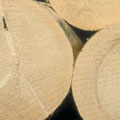A building material with a bright future
Thick-trunk timber is better than its reputation

Thick-trunk timber is very suitable for beams and panels with large loading capacity and visually appealing surfaces
04.03.2009, Press releases
As winter wanes foresters are coming to the end of a work-intensive period: timber harvest time. Many forest owners wonder just how to market the freshly felled, large-diameter trunks. The problem is that thick trunks over 40 cm in diameter are hard to sell. Modern sawmills and the wood industry as a whole prefer thinner logs, which are easier to process. However, as researchers from the Technische Universität München (TUM) have shown, they are mistaken: A new processing technology is giving the image of the “thick trunks” a leg up.
Modern wood technology increasingly requires standardized timber products for visually appealing facades and large-span, load-bearing structures. Many private forest owners in Bavaria with a significant share of large diameter trees have so far failed to take advantage of this market opportunity. The fact is that the wood industry has a clear preference for thinner logs – cartwheel diameters are rarely sought after. But scientists from the TUM are coming to the aid of foresters: Prof Gerd Wegener, Prof Peter Glos and forest assessor Michael Tratzmiller have succeeded in demonstrating how the hitherto underrated large-diameter trees can triumph in the discerning wood market.
The researchers are well aware that there is lumber and lumber - and the differences go beyond the just wood species, such as spruce, fir or larch. Trunks have different properties at the base and at the top; heartwood from the core of the trunk is quite different from the peripheral sapwood. Sapwood timber from large-diameter trunks has three advantages when compared to heartwood timber or timber from thinner trunks. First, it is harder due to its gross density and the fact that there are proportionally fewer branches. Second, cracks and twisting in the grain are less likely to occur. And third, the cross-sections of large diameter logs are less likely to warp while drying.
In order to fully utilize the potential of large diameter trees, it is essential that the trunks are sawn properly and sorted according to the intended use. With regard to the proper sawing technique, the TUM wood researchers have a concrete recommendation. To obtain a large number of planks of high strength it is important to consider the position of the annual rings. Here, the so-called rift sawing technique is ideal: The logs are sawn “with vertical growth rings”. This results in boards with particularly high stability, because the growth rings of the tree are perpendicular to the width of the board and grain contortions stemming from branches are less common.
Afterwards, the lumber – referred to as beams or boards, depending on its dimensions – can be sorted visually as well as mechanically. The TUM researchers found that the new generation sorting machines that are capable of determining the gross density and stiffness of the wood, as well as the branch density, provide a practicable alternative to the keen eye of the expert. After being sorted by stiffness, the lumber can be processed further: The so-called rifts, which result from rift sawing, are very well suited to the production of light beams and panels with high loading capacity.
The Chair of Wood Science and Technology at the TUM developed the process in collaboration with partners in the field. The TUM researchers showcase their innovative findings to architects and industry representatives in workshops and at various fairs. The feedback justifies the claims of the wood researchers: Thick-trunk lumber is a material with a bright future.
Contact:
Technische Universität München
Chair of Wood Science and Technology
Prof Gerd Wegener
80797 Munich
Tel. 089 / 2180 - 6420
E-Mail: wegener@wzw.tum.de
http://www.holz.wzw.tum.de/
Kontakt: presse@tum.de
More Information
| 090304-Stammholz.pdf |
Druckversion dieser Pressemitteilung,
(Type: application/pdf,
Size: 130.6 kB)
Save attachment
|
|
| 090304-thick-trunk.pdf |
Print version of this press release,
(Type: application/pdf,
Size: 138.6 kB)
Save attachment
|



